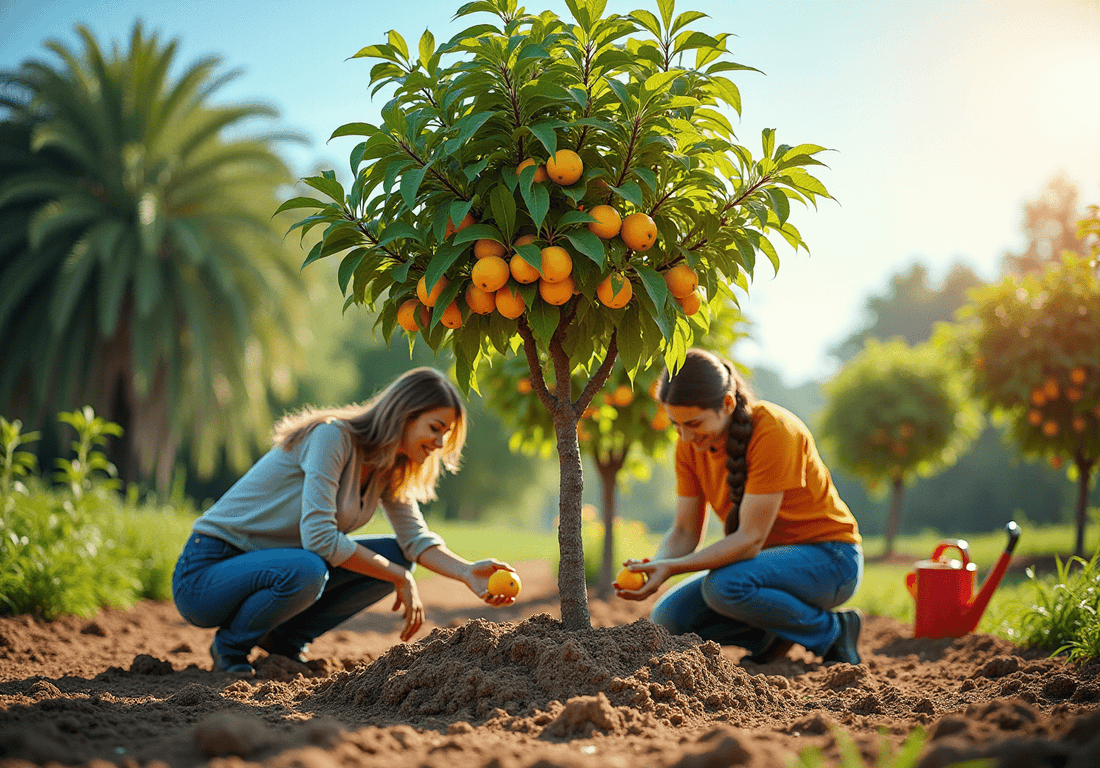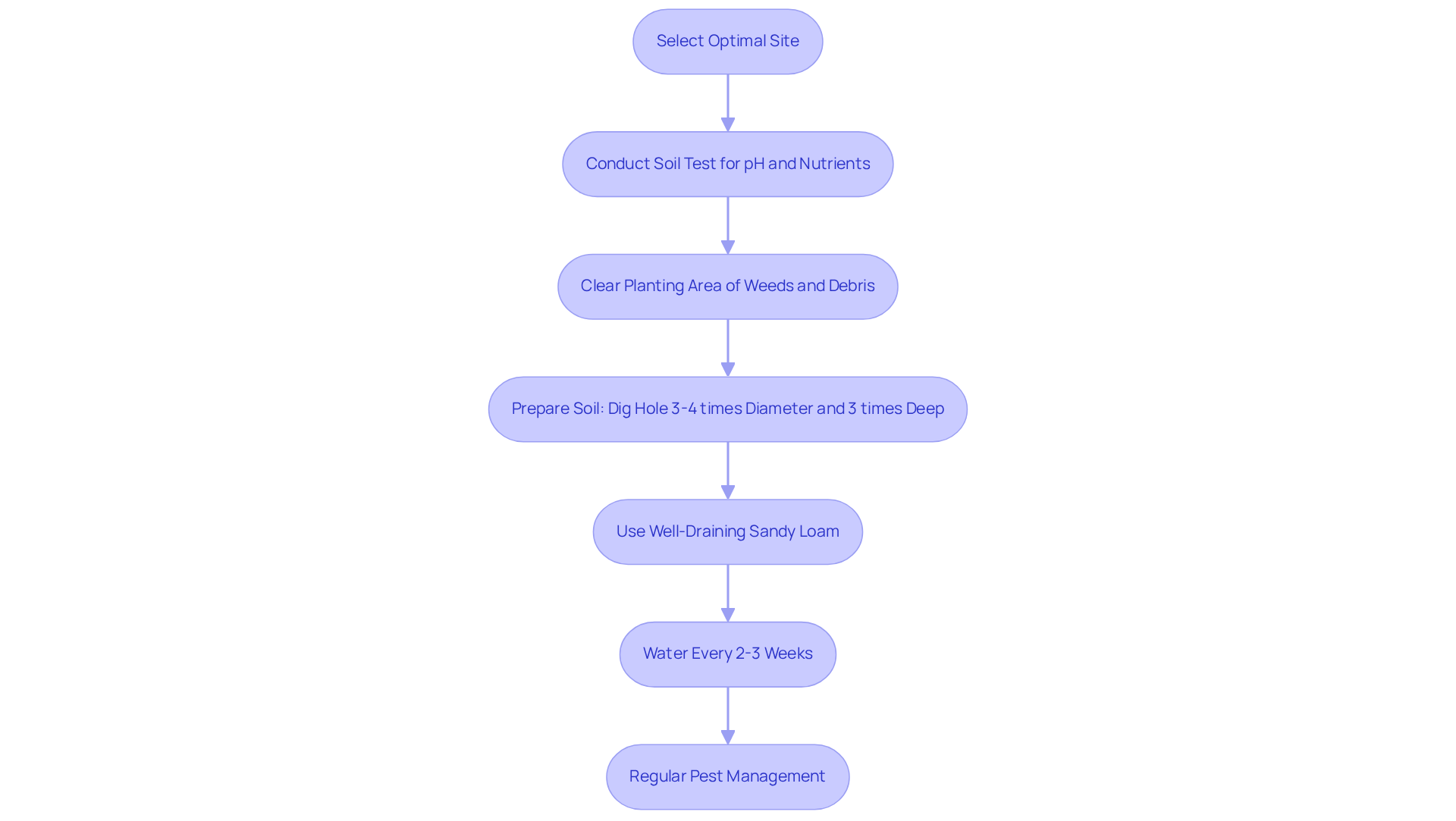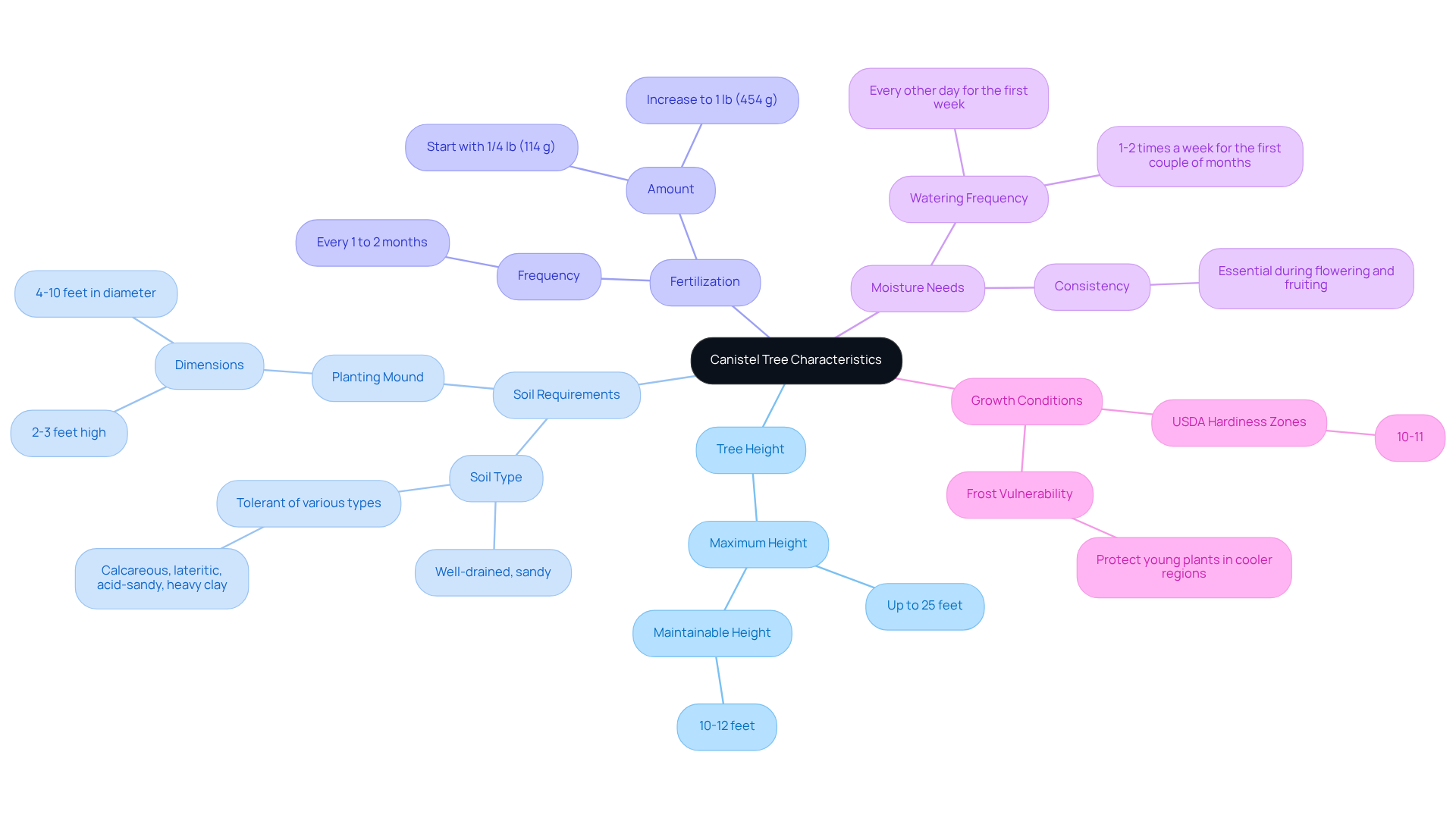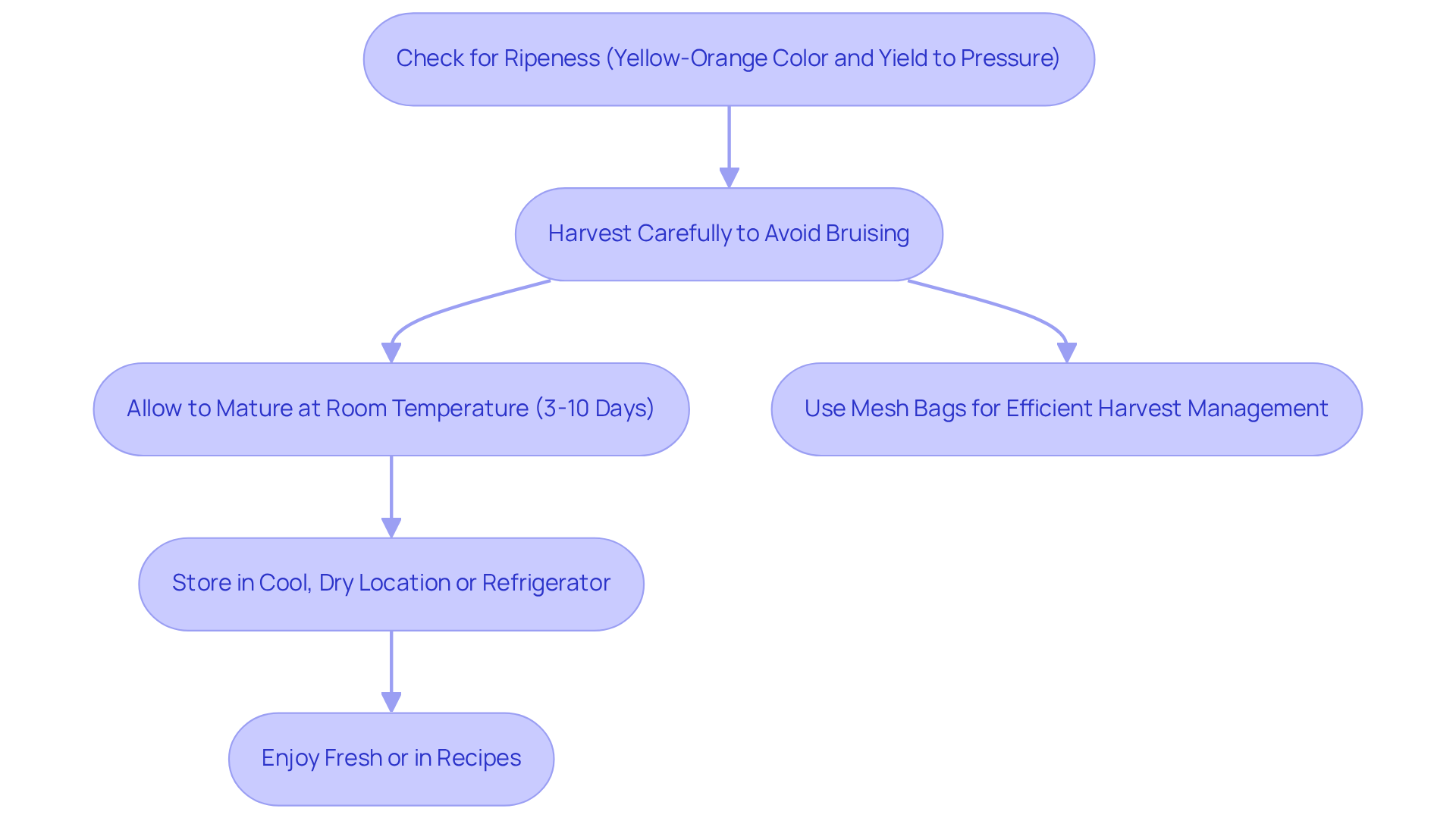
Essential Practices for Growing a Yellow Canistel Tree
Share
Cultivating a yellow canistel tree offers a rewarding journey into the world of tropical fruit gardening, where the right practices can lead to bountiful harvests of this unique and flavorful fruit. By understanding the essential requirements—from site selection and soil preparation to ongoing care and pest management—gardeners can create an optimal environment for their trees to thrive.
However, the challenge remains: how can one balance these diverse needs to ensure healthy growth and a high-quality yield? This article delves into the best practices for nurturing yellow canistel trees, equipping readers with the knowledge to overcome common obstacles and enjoy the fruits of their labor.
Want to grow a Canistel Tree in your garden?
Explore a Yellow Canistel Tree for sale at Everglades Farm - shipped directly from Florida.
Select Optimal Site and Prepare Soil for Canistel Trees
To cultivate a thriving yellow canistel tree, begin by selecting a site that receives full sun for at least 6-8 hours each day. This plant thrives in warm, humid conditions; therefore, a site with good air circulation is essential. Prior to planting, conduct a test on the ground to evaluate pH and nutrient levels, ensuring ideal conditions for growth. Clear the planting area of weeds, rocks, and debris to reduce competition for nutrients and water.
For ground preparation, dig a hole that is 3-4 times the diameter and 3 times as deep as the tree's container. This practice loosens the surrounding earth, facilitating root growth. Utilize well-draining sandy loam soil enriched with organic matter, such as compost, to enhance moisture retention while preventing waterlogging. Aim for a slightly acidic to neutral pH range of 6.0 to 7.0 to optimize nutrient absorption. Additionally, ensure adequate spacing of 15-20 feet for standard varieties and 10-12 feet for dwarf varieties to promote air circulation and sunlight exposure.
to maintain steady moisture, providing it with the best opportunity for healthy development and yield. For pest management, regularly examine the plant for signs of pests such as aphids or scale insects. Consider using organic insecticidal soap if infestations arise. For those also interested in cultivating soursop or passion fruit, similar practices apply: ensure ample sunlight, a well-draining substrate, and regular watering, while remaining vigilant about pest management to protect your tropical fruit garden.

Implement Care Practices for Healthy Growth
Regular care is essential for the robust growth of the yellow canistel tree. During the establishment phase, it is crucial to water the plant thoroughly and consistently, allowing the ground to dry slightly between sessions to prevent root rot. A bi-monthly application of a balanced, slow-release fertilizer tailored for fruit trees is recommended, with a focus on high phosphorus content during the flowering stage to promote optimal fruit set. Essential nutrients such as nitrogen, phosphorus, potassium, calcium, and magnesium should be included in the fertilization plan. In South Florida, to ensure a consistent supply of nutrients. Additionally, maintaining an optimal pH range of 6 to 6.5 is vital for improved nutrient availability.
Pruning should be conducted annually in late winter or early spring to eliminate dead or crowded branches, enhancing air circulation and sunlight penetration. Furthermore, applying compost or organic matter early in the season can improve soil health and nutrient availability. It is important to keep watch for pests like scale insects and mealybugs, addressing any infestations quickly with insecticidal soap or neem oil to preserve plant health. For those cultivating passion vines next to yellow canistel trees, vigilance is necessary for spotting passion vine hoppers, which can harm your vegetation. Implementing organic pest control strategies by identifying these pests early and using natural methods to manage their populations effectively will contribute to the overall health of your plants.
Understand Canistel Tree Characteristics and Environmental Needs
The yellow canistel tree, scientifically known as Pouteria campechiana and commonly referred to as egg fruit, is an evergreen specimen that can reach heights of up to 25 feet. However, with regular pruning, they can be maintained at a more manageable size. These plants flourish in well-drained, sandy ground and exhibit moderate drought resistance once established.
To ensure optimal growth, it is advisable to plant the fruit-bearing specimens on a mound composed of native soil, measuring 2 to 3 feet high and 4 to 10 feet in diameter. Additionally, removing a ring of grass sod, ranging from 3 to 10 feet in diameter around the planting area, is crucial for successful establishment.
Young canistel plants should be during their first year, starting with 1/4 lb (114 g) of fertilizer and increasing to 1 lb (454 g) per plant. Despite their resilience, consistent moisture is essential during the flowering and fruiting stages to ensure optimal yield.
The produce typically ripens from November to March, and these plants are vulnerable to frost; therefore, in cooler regions, protective measures are vital to shield young plants.
Canistel thrives in USDA hardiness zones 10-11, making them ideally suited for tropical and subtropical climates. By understanding these traits, gardeners can create the perfect environment for their trees, ultimately boosting growth and yield.

Harvest and Manage Canistel Fruits for Optimal Quality
Harvest produce from the yellow canistel tree when they turn yellow-orange and yield slightly to gentle pressure, indicating optimal ripeness. It is crucial to handle the produce carefully to avoid bruising, as the peel is delicate. After gathering, allow the produce to mature at room temperature for 3 to 10 days until they reach a soft texture, enhancing their flavor. To extend freshness, or in the refrigerator for a few weeks, as this can enhance their sweetness.
Canistel produce is versatile, enjoyed fresh or included in various culinary creations, such as smoothies and desserts. Effective management of the harvest is essential to ensure that the fruits retain their quality and delightful flavor; using mesh bags to catch falling fruits is one effective strategy. Additionally, yellow canistel trees thrive in sandy loam or loamy soils and prefer full sunlight, making these important considerations for home gardeners.

Conclusion
Successfully cultivating a yellow canistel tree requires a comprehensive understanding of its needs and the implementation of essential care practices. By selecting an optimal site, preparing the soil meticulously, and maintaining consistent care, gardeners can foster an environment where these trees can thrive and produce delicious fruit.
Key practices include:
- Providing adequate sunlight
- Ensuring proper soil drainage
- Regular watering to maintain moisture levels
- Nutrient management through thoughtful fertilization
- Vigilant pest control to enhance the health of the tree
Understanding the unique characteristics of the yellow canistel tree, such as its height and fruiting habits, is crucial for effective cultivation and harvesting.
In conclusion, growing a yellow canistel tree is a rewarding endeavor that not only yields delightful fruits but also enriches the gardening experience. By adhering to these best practices, gardeners can maximize fruit quality and ensure a bountiful harvest. Embracing these techniques will lead to a flourishing canistel tree, contributing to a vibrant tropical garden and a sustainable food source.
Grow Your Own Delicious Canistel Tree Today!
Start your gardening journey with Everglades Farm and enjoy the fruits of your labor.
Frequently Asked Questions
What conditions are ideal for planting yellow canistel trees?
Yellow canistel trees thrive in full sun for at least 6-8 hours each day and prefer warm, humid conditions with good air circulation.
How should I prepare the soil before planting canistel trees?
Conduct a soil test to evaluate pH and nutrient levels, clear the area of weeds and debris, and dig a hole that is 3-4 times the diameter and 3 times as deep as the tree's container. Use well-draining sandy loam soil enriched with organic matter like compost.
What is the ideal pH range for planting canistel trees?
The ideal pH range for canistel trees is slightly acidic to neutral, between 6.0 and 7.0.
How much space should I allow between canistel trees?
For standard varieties, allow 15-20 feet of spacing, and for dwarf varieties, allow 10-12 feet to promote proper air circulation and sunlight exposure.
How often should I water yellow canistel trees?
Water the yellow canistel tree every 2-3 weeks to maintain steady moisture for healthy growth and yield.
What should I do if I notice pests on my canistel tree?
Regularly examine the plant for pests such as aphids or scale insects, and consider using organic insecticidal soap if infestations occur.
Do the same planting practices apply to other tropical fruits like soursop or passion fruit?
Yes, similar practices apply for cultivating soursop or passion fruit, including ensuring ample sunlight, a well-draining substrate, regular watering, and vigilant pest management.


